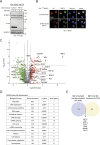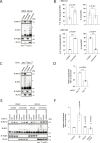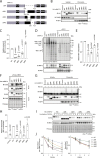Chromatin targeting of the RNF12/RLIM E3 ubiquitin ligase controls transcriptional responses
- PMID: 38199845
- PMCID: PMC10781586
- DOI: 10.26508/lsa.202302282
Chromatin targeting of the RNF12/RLIM E3 ubiquitin ligase controls transcriptional responses
Abstract
Protein ubiquitylation regulates key biological processes including transcription. This is exemplified by the E3 ubiquitin ligase RNF12/RLIM, which controls developmental gene expression by ubiquitylating the REX1 transcription factor and is mutated in an X-linked intellectual disability disorder. However, the precise mechanisms by which ubiquitylation drives specific transcriptional responses are not known. Here, we show that RNF12 is recruited to specific genomic locations via a consensus sequence motif, which enables co-localisation with REX1 substrate at gene promoters. Surprisingly, RNF12 chromatin recruitment is achieved via a non-catalytic basic region and comprises a previously unappreciated N-terminal autoinhibitory mechanism. Furthermore, RNF12 chromatin targeting is critical for REX1 ubiquitylation and downstream RNF12-dependent gene regulation. Our results demonstrate a key role for chromatin in regulation of the RNF12-REX1 axis and provide insight into mechanisms by which protein ubiquitylation enables programming of gene expression.
© 2024 Espejo-Serrano et al.
Conflict of interest statement
The authors declare that they have no conflict of interest.
Figures










Similar articles
-
RNF12 X-Linked Intellectual Disability Mutations Disrupt E3 Ligase Activity and Neural Differentiation.Cell Rep. 2018 May 8;23(6):1599-1611. doi: 10.1016/j.celrep.2018.04.022. Cell Rep. 2018. PMID: 29742418 Free PMC article.
-
An RNF12-USP26 amplification loop drives germ cell specification and is disrupted by disease-associated mutations.Sci Signal. 2022 Jul 12;15(742):eabm5995. doi: 10.1126/scisignal.abm5995. Epub 2022 Jul 12. Sci Signal. 2022. PMID: 35857630 Free PMC article.
-
Activity-based probe profiling of RNF12 E3 ubiquitin ligase function in Tonne-Kalscheuer syndrome.Life Sci Alliance. 2022 Jun 28;5(11):e202101248. doi: 10.26508/lsa.202101248. Print 2022 Nov. Life Sci Alliance. 2022. PMID: 35764390 Free PMC article.
-
How does the Xist activator Rlim/Rnf12 regulate Xist expression?Biochem Soc Trans. 2024 Jun 26;52(3):1099-1107. doi: 10.1042/BST20230573. Biochem Soc Trans. 2024. PMID: 38747697 Free PMC article. Review.
-
Regulation of E3 ubiquitin ligases by homotypic and heterotypic assembly.F1000Res. 2020 Feb 6;9:F1000 Faculty Rev-88. doi: 10.12688/f1000research.21253.1. eCollection 2020. F1000Res. 2020. PMID: 32076548 Free PMC article. Review.
Cited by
-
RLIM-specific activity reporters define variant pathogenicity in Tonne-Kalscheuer syndrome.HGG Adv. 2025 Jan 9;6(1):100378. doi: 10.1016/j.xhgg.2024.100378. Epub 2024 Oct 31. HGG Adv. 2025. PMID: 39482882 Free PMC article.
References
Publication types
MeSH terms
Substances
Grants and funding
LinkOut - more resources
Full Text Sources
Molecular Biology Databases
Research Materials
